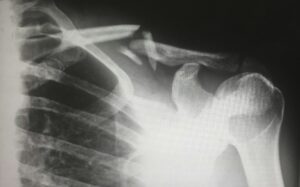Table of Contents
ToggleBlunt Force Head Trauma — Causes and Effects
Blunt force head trauma is a leading cause of severe injury and often leads to lasting brain damage. Many situations can lead to this type of injury. When someone else is responsible for an accident that results in blunt force trauma, the responsible party — or their insurance provider — can be liable for the damage.

Knowing the symptoms of blunt force trauma can help ensure that you promptly seek medical attention. A personal injury lawyer can help recover compensation and protect you from paying a steep price for someone else’s negligence.
What Is Blunt Force Head Trauma?
Blunt force trauma is a general term for any non-penetrative blow to the head. This type of injury most often occurs when the head comes into contact with a blunt object — hence the name of the injury.
By contrast, the other primary type of head trauma is penetrative trauma. In this type of injury, the head makes contact with an object sharp enough to pierce the skull.
Blunt force trauma often comes with a higher risk of delaying medical attention; since there may be no visible sign of injury, there’s a greater risk that complications like brain swelling or brain bleeding may initially go undetected.
Not all blunt force trauma is the same. There are two main types: contusions and concussions. Both are serious injuries that come with serious risks.
Contusion injuries are often likened to a brain bruise. A contusion may involve swelling or bleeding at the site of impact.
A concussion involves loss of regular brain function caused by the force of impact. Concussions are the most common type of brain injury. Concussions typically heal with time and rest, but they are accompanied by a risk of complications, especially if medical attention is not sought immediately after the injury.
How Does Blunt Force Head Trauma Happen?
Blunt force trauma is a possible outcome of any type of accident involving a blow to the head.
Some of the situations that most commonly lead to blunt force trauma include:
- Car accidents
- Falls
- Slip and fall accidents
- Physical assault
- Sporting accidents
- Motorcycle accidents
It’s also possible to experience blunt force trauma in situations where the head didn’t actually make physical contact with another object. For example, if a driver slams on the brakes in an attempt to avoid a car accident, the sudden braking can cause the brain to slam into the side of the skull, leading to a blunt force trauma injury.
How Is Blunt Force Head Trauma Treated?
Any type of head trauma requires immediate medical care. How a head injury is treated will depend on several factors, such as the level of visible injury and the patient’s level of consciousness.
Diagnosing blunt force trauma may involve:
- Physical exam
- CT scan
- MRI imaging
- Blood tests
- Cognitive testing
If serious injury is suspected, medical staff will likely perform imaging tests to get a picture of what’s happening inside a patient’s skull. They’ll also likely perform simple tests of memory, problem-solving skills, and other areas of brain function that are commonly affected by a blunt force trauma injury.
Once medical staff has identified the level of injury, they’ll decide on the form of treatment needed. In the most straightforward cases, a patient may simply be diagnosed with a concussion and sent home to rest. In more severe cases, such as those involving bleeding or swelling in the brain, a patient may need emergency surgery.
What Are the Long-Term Effects of Blunt Force Head Trauma?
The brain is a highly complex organ, and no two brain injuries produce the same results. A patient’s long-term outcome after sustaining a blunt force trauma injury depends heavily on the extent of the injury and any complications.
In some cases, such as those involving a mild concussion, full recovery is the expected outcome. After more severe injuries or those involving complications, the result can be catastrophic.
The victim of a serious head injury may be left with life-altering effects. They may be unable to return to work or complete daily tasks without help. Some victims may require assistive care for years to come.
A severe head injury seriously reduces the quality of life for a victim and their loved ones. Such an injury can also have a profound financial impact on the family members left to care for an injured loved one.
Surgeries, medical procedures, assistive care, and the loss of the victim’s income are all common financial consequences that come out of a serious injury involving blunt force trauma.
Blunt Force Head Trauma Symptoms
Symptoms of a blunt force trauma injury can vary widely. In some cases, it might be evident from the moment of the accident that the victim needs emergency medical attention. In other cases, symptoms might be delayed — an individual may not experience symptoms until a few hours, days, or even weeks after the accident.
Some of the most common symptoms of a blunt force trauma injury include:
- Headache
- Dizziness or disorientation
- Confusion
- Memory or thinking issues
- Mood or personality changes
- Vision issues
- Speech issues
- Loss of consciousness
- Convulsions
- Paralysis
Long-term outcomes can vary by individual. With more severe injuries, symptoms like those listed above can remain with the person even after the physical injury has healed.
Complications like bleeding and swelling in the brain are often fatal unless medical attention is received promptly. Knowing the signs of blunt force trauma can guide an injured person or their loved one to seek out potentially life-saving medical attention.
Recovering Personal Injury Compensation After Blunt Force Head Trauma
A brain injury is one of the most complicated and life-altering types of injuries a person can experience.
Even when the victim makes a full recovery, they may be left with extensive medical debt for the treatment they received. When recovery is not possible after a blunt force trauma injury, the victim’s loved ones may find themselves struggling to afford the cost of lifelong care.
Los Angeles brain injury lawyers work with victims and their families to recover compensation for the accident that resulted in a blunt force trauma injury. A serious head injury is an emotionally devastating event, but a brain injury lawyer can help ensure it’s not also a financially devastating one.
Contact Our Brain Injury Law Firm in Los Angeles, CA
If you were injured in an accident in Los Angeles, CA or you lost a loved one and you need legal assistance, please contact us to schedule a free consultation. One of our Los Angeles car accident lawyers at M&Y Personal Injury Lawyers will get in touch with you soon.
M&Y Personal Injury Lawyers – Los Angeles Office
4929 Wilshire Blvd Suite 960,
Los Angeles, CA 90010
866-864-5477
M&Y Personal Injury Lawyers – Downtown Office
350 S Figueroa St Suite 276
Los Angeles, CA 90071
(877) 751-8953



